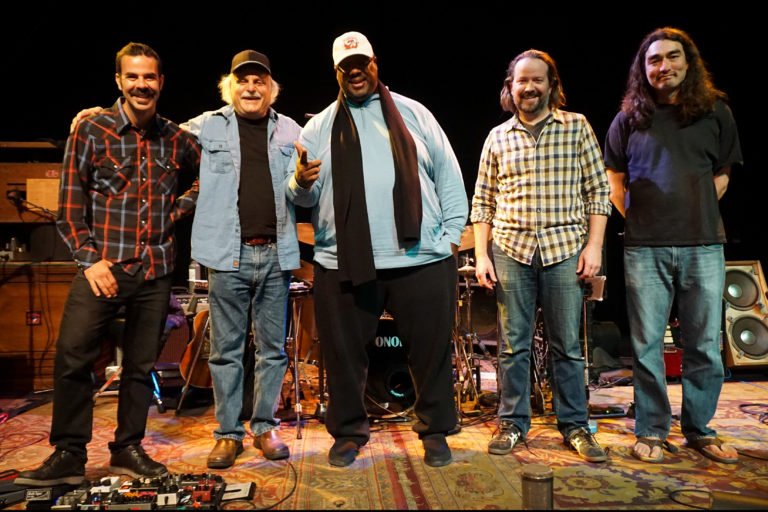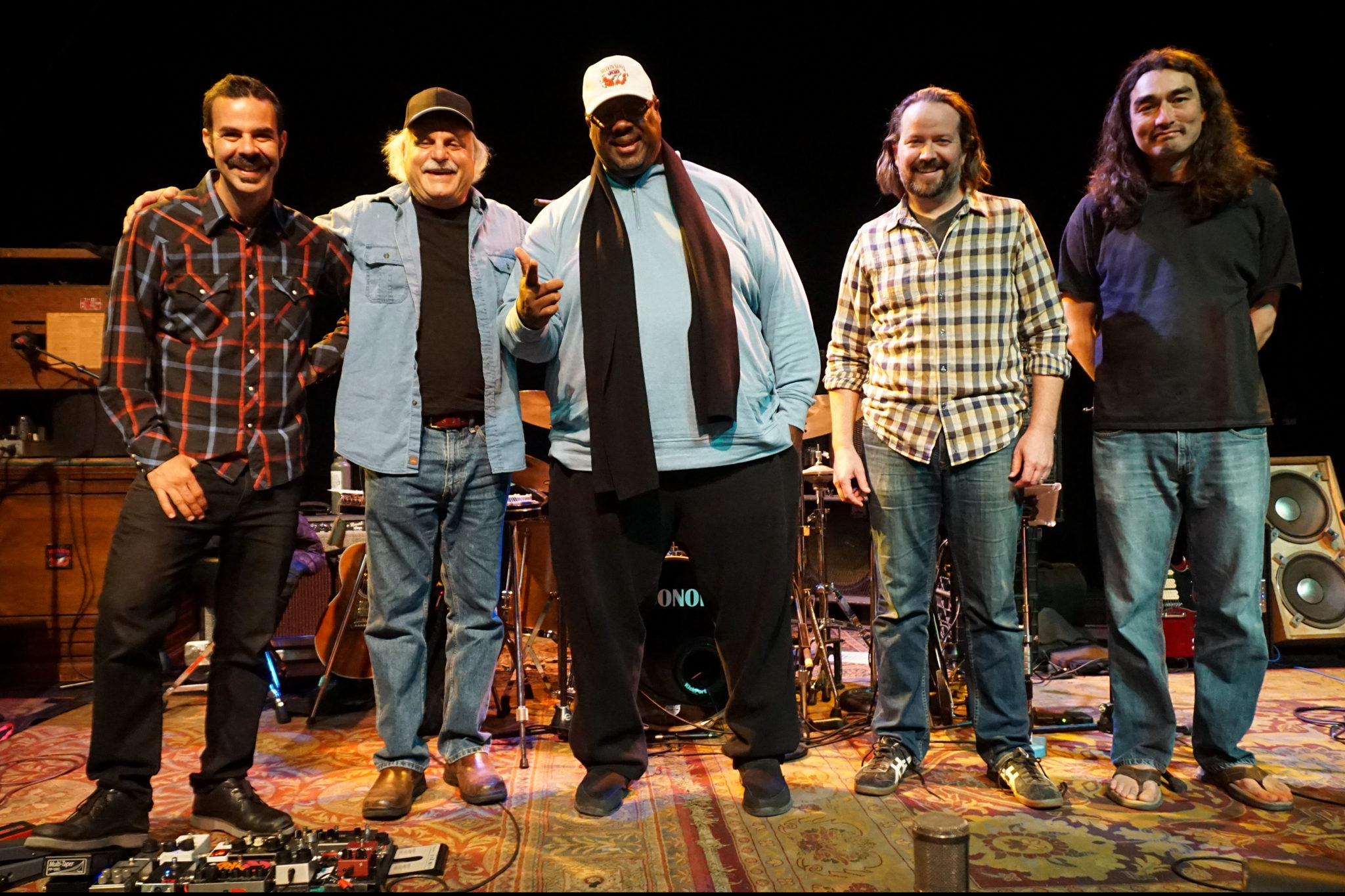By Will Parrish
On a rainy weekday afternoon last November, about 20 people from Northern California joined a 200-person rally outside the Oregon capitol in Salem. They had assembled partly in support of the struggle against the Dakota Access Pipeline (DAPL) in North Dakota. In the weeks prior, police on the northern Great Plains had inflicted beatings on anti-DAPL protesters, shot hundreds with concussion grenades and rubber bullets and even deployed military-surplus equipment such as armored vehicles and a long-range acoustic device, a noisy crowd-control device that reportedly shattered at least one person’s eardrums.
The main focus of the Salem demonstration, however, was an infrastructure project similar to the DAPL but much closer to home. Spurred by the newfound ability to extract vast shale deposits from the Rocky Mountains’ western slopes via hydraulic fracturing (fracking), a Canadian oil and gas company named Veresen has proposed to ship natural gas from the Rockies west to Asian markets via a newly constructed liquefied natural gas (LNG) terminal in Coos Bay, Ore., where gas would be chilled and liquefied for easier and cheaper storage and transport. Known as the Jordan Cove Energy Project (JCEP), it would be the first Pacific Coast LNG terminal.
The terminal would be supplied by the 233-mile Pacific Connector Gas Pipeline, which would originate at a natural gas transport hub near Malin, Ore., and snake beneath five major rivers on its way to Coos Bay. One river beneath which the pipeline would be plumbed is the mighty Klamath, which rises in southern Oregon and meets the ocean roughly 240 miles away at the Humboldt-Del Norte county lines.
At the rally, indigenous people from the Klamath Basin talked about building a stronger interstate alliance against the project.
“We gotta help our neighbors, the Oregonians!” said a Hoopa Valley tribal member who identified herself as Missy and who lives along the Klamath River in Northern California, into a bullhorn. “They may not know they need our help. But they need our help!”
Missy then pondered whether opposition to the JCEP would require a direct-action campaign similar to the one at Standing Rock.
“I look at what’s going on over at Standing Rock, and it makes me scared. But if we have to do the same thing here, will you do that with us here?” she asked. The crowd let out an affirmative whoop.
Frack Attack
The nationwide boom in fracking has fostered numerous proposals to push oil and natural gas out to coastal ports through newly constructed pipelines, but resistance to these plans is also increasing, in part because thousands of people who visited Standing Rock last fall returned home and took up local fights.
In 2016, the Federal Energy Regulatory Commission (FERC) twice rejected Veresen’s applications to build the JCEP. Leaders of Donald Trump’s administration, however, have vowed to see the project through. At a presentation to the Institute of International Finance forum in Washington on April 20, Gary Cohn, director of the White House National Economic Council (and former Goldman Sachs president), vowed that Trump will step up approvals for LNG export terminals in the name of boosting the U.S. economy, and then specifically referred to the Jordan Cove project.
“The first thing we’re going to do is we’re going to permit an LNG export facility in the Northwest,” Cohn said.
California has a critical link to the JCEP: The 680-mile Ruby Pipeline, completed in 2011, which delivers the natural gas from the Rocky Mountain gas fields—the Jonah Field in Wyoming, the Piceance Basin in Colorado, the Uintah Basin in northern Utah—to Oregon. Northern California’s main electricity supplier, PG&E, is one of three companies that helped build the Ruby Pipeline and remains a part owner of it. PG&E’s network of pipelines deliver Ruby Pipeline gas to the North Bay and other regions of the Golden State.
The Pacific Connector Gas Pipeline, too, would tie into the Ruby Pipeline, without which the JCEP could not be built.
Opponents of the JCEP are mounting increasing pressure on Oregon’s elected officials to stop the project, but even the state’s Democratic Party leaders have either embraced the JCEP or stood aside. So far, a combination of grassroots opposition and questionable economics have combined to delay the project, and now many opponents are talking about the possibility of mounting a massive direct action civil disobedience campaign.
Perry Chocktoot, a member of the Klamath Tribal Council in Chiloquin, Ore., says that indigenous people from throughout the region will be increasingly asserting themselves in the struggle from this point forward. “If this thing gets approved,” he says, “we’re going to call tribes from all over the U.S., Mexico and Canada, to ask for solidarity.”
A Long Time Coming
The struggle concerning the JCEP has been ongoing for more than a decade. The Federal Energy Regulatory Commission first considered Jordan Cove in 2007. Back then, it was proposed as an import project, which would have funneled gas from Russia or the Middle East to consumers on the West Coast, especially California.
In 2009, FERC issued a permit, but vacated the decision in 2012 as import prospects sank. Then the meltdown at Japan’s Fukushima power plant created a different opportunity. After the disaster, Japan and other Asia Pacific countries began phasing out nuclear power and replacing it mostly with LNG. In 2013, a Veresen subsidiary resubmitted an application to FERC that re-envisioned Jordan Cove as an export terminal that could ship 1 billion cubic feet of gas a day. That’s enough to meet 8 percent of Japan’s current demand.
A March 2016 FERC order denying the application noted that Veresen and its partner at the time, Williams Companies of Oklahoma, failed to prove that adequate demand for its product exists in Asia and also noted the “significant opposition from directly-impacted landowners.”
In September, Trump alluded to the JCEP on the campaign trail, during a speech to an oil and gas drilling conference in Pittsburgh, FERC’s failure to support it as an alleged example of “the Obama/Clinton restriction agenda.” In February, Trump appointed Veresen CEO Don Althoff as a member of his “infrastructure team” that is developing recommendations on moving major building projects more quickly through regulatory reviews. He is in the process of nominating three new members to the five-member FERC, one of whom, Pennsylvania Public Utility Commissioner Robert Powelson, a Republican, has stated that people opposing pipeline projects are engaged in a “jihad.”
For most of the past decade, landowners along the pipeline right-of-way have been the backbone of an opposition movement to it. This opposition runs the political gamut and includes conservatives concerned with private property rights and the damage to the land.
“This company, Veresen, has no concept of what the land means to us,” says Bill Gow, who labels himself a reluctant Donald Trump supporter and who owns a 2,500-acre ranch in Myrtle Creek, Ore., which the pipeline would cut through. “We didn’t choose to live in these places for the money, but that’s all the company cares about.”
Opponents note the economic damage the project would wreak on landowners along the pipeline route, as well as the far greater number of jobs that would result from investments in renewable energy. Moreover, the Jordan Cove terminal would be built in a region vulnerable to tsunamis and earthquakes, while the pipeline, full of high-pressure gas, would pass through an area with a high risk of wildfires. The pipeline would also entail a 100-foot-wide linear clear cut across more than 60 miles of mature second- and old-growth forests.
Other critics cite climate change as an overriding concern. Since the turn of the millennium, the planet has burned through global temperature records, meaning the sorts of harrowing scenarios climate scientists have long predicted—such as rising seas that swallow up cities, more wrathful storms and droughts and an accelerating decline in global biodiversity—are increasingly close at hand or already occurring. While natural gas is often touted as a cleaner burning energy source than coal, fracking wells have been documented to leak substantial amounts of methane, a powerful greenhouse gas that makes gas-fired electricity a worse contributor to the global climate crisis than coal.
By giving Western producers access to the world’s largest gas market (consisting of Japan, the biggest consumer, South Korea, Taiwan and other Asia-Pacific countries), the JCEP could set off a new drilling boom on public lands, particularly in the Piceance Basin of the Rocky Mountains.
In a shocking announcement last July, the U.S. Geological Survey deemed the western Colorado gas basin to have the second largest reserve of recoverable natural gas in the United States. The announcement thrilled the region’s political and business leaders, who are increasingly clamoring for the JCEP’s approval.
Easy Pickings
If built, the project would pull 438 billion cubic feet of natural gas per year out of the ground—almost twice the amount Oregon as a whole consumed in 2015. Construction unions wield enormous power within Oregon’s Democratic Party. They highlight that the project would bring about 150 permanent jobs to the economically stagnant Coos Bay region, also paving the way for a significant expansion of the city’s port through dredging. It would also create an estimated 930 jobs during its four-year construction phase.
“There are thousands of qualified pipefitters, electricians, laborers, sheet metal workers, ironworkers and boilermakers across Oregon that will benefit from this work, receiving good wages with benefits for three years of construction,” says John Mohlis, Oregon State Building and Construction Trades Council executive secretary.
The port of Coos Bay was among the world’s largest shipping areas for lumber in the 1970s and ’80s, and the promise of new jobs at the declining port has elicited enthusiastic support from area business leaders. Jody McCaffree, a landowner outside of Coos Bay, sees the targeting of this economically depressed area as deliberate, saying that the Jordan Cove consortium chose Coos Bay because the residents in the pipeline route have fewer resources to oppose the project than places like the San Francisco Bay Area, which has larger ports than Coos Bay but doesn’t have “the large environmental groups or the resources like you [find] in California to fight destructive projects like this.
“Truth be known,” McCaffree continues, “Jordan Cove came to Coos Bay because every LNG import proposal in California—and there were quite a few at the time—had been derailed for some reason or another. The industry saw Coos Bay as easy pickings.”
Most of Oregon’s elected leaders—including most Democratic Party officials, many of whom support measures to reduce greenhouse gas pollution in other contexts—support the pipeline on economic grounds. Oregon’s State Land Board would need to issue Veresen a permit for the pipeline to be built through coastal Oregon. Governor Kate Brown is a member of the State Land Board and appoints its other two members, but she has largely stood aside as Veresen has attempted to muscle its way through state and local regulatory processes.
“It’s incredibly frustrating for communities that are most impacted by this pipeline to see our state government saying they are ready to take action on climate change, but not taking a stand on what could be the largest source of climate pollution in the state,” says Hannah Sohl, executive director of the Medford-based group Rogue Climate, a leading voice of opposition to the JCEP.
Even Democratic U.S. Sen. Jeff Merkley, who co-sponsored a bill earlier this year to eliminate 100 percent of U.S. fossil fuel consumption by the year 2050, has tepidly supported the Jordan Cove proposal.
Climate Defenders
In the absence of federal legislation to scale back the United States’ outsized role in causing and perpetuating the global climate crisis, the West Coast has emerged as one of the world’s most significant climate-change battlegrounds. In recent years, California, Oregon, Washington and British Columbia have faced a spate of new fossil-fuel infrastructure projects, but grassroots opposition has helped defeat most of them.
Eric de Place, the policy director of the Seattle-based Sightline Institute, a climate-change think tank, conceives of the Pacific Northwest as a “thin green line,” since it stands squarely between Asia’s voracious energy markets and huge fossil-fuel deposits in North America’s interior.
Since 2010, Oregon, Washington and British Columbia have faced proposals for roughly 25 LNG terminals, along with six coal export terminals, 15 oil-by-rail facilities and several major new oil and gas pipelines.
A poor economic outlook dealt the fatal blow to many of these proposals, including all of the coal export proposals. De Place says “the Jordan Cove project is far from a slam dunk” for Veresen. That’s particularly the case, he notes, because it is competing for markets and investors with the swarm of British Columbia LNG export proposals, which are competing against it in a finite global market for LNG products.
De Place hastens to note that the Obama administration was also not particularly friendly to the cause of reining in fossil-fuel production. “If anything, the Obama administration was hostile to our cause,” de Place says. “Almost all of the victories we have won so far against new fossil-fuel infrastructure have been fought and won at the local level.”
Still, the Trump administration’s loud support for the project had made Veresen increasingly optimistic about the project’s chances. On December 9, hours after FERC denied Veresen’s application to build the project, company lobbyist Ray Bucheger wrote a conciliatory email to three Colorado-based oil and gas industry executives with a stake in the project, which were obtained for this story through a records request.
“We are currently evaluating our options, but I will say that we need Mr. Trump and his team now more than ever,” Bucheger stated.
Veresen has announced that it will resubmit its application to FERC in August, and that it is optimistic about receiving federal approval in 2018 or 2019.
Indigenous Opposition
As with the DAPL and Keystone XL pipeline struggles, indigenous people are likely to play a key role in the project’s outcome. The Karuk, Yurok and Klamath tribes have all passed resolutions opposing it. They note that it threatens cultural resources, traditional tribal territories and burial grounds. Numerous individual members of the Confederated Tribes of Siletz Indians, the Cow Creek Band of Umpqua Tribe of Indians and the Confederated Tribes of Coos, Lower Umpqua and Siuslaw Indians have also come forward to oppose it.
Within California, very few groups have defended water resources as strongly as Klamath Basin tribes, for whom the river’s storied fisheries form a basis of their survival as distinct cultures. Many have fought for years to remove four hydroelectric dams on the Klamath River. They had a major presence at the DAPL struggle on the North Dakota plains, and around 75 traveled by bus to speak out at a series of open houses in Oregon in early March. They have expressed their concerns about the potential for damage to the river during both the pipeline construction process, as well as from potential leaks and spills.
Sammy Gensaw, a 22-year-old Yurok fisherman from Klamath Glen, Calif., notes that indigenous people have developed long-term resilience that is now lending itself to the struggle against the global climate crisis. Indigenous people know what it’s like to be pushed to the edge of survival, he says, and because of climate change, existential threats are now something that all of humanity shares in common.
“The first fight of my ancestors was to have blood flow through their veins and air in their lungs, because at one point, the U.S. government deemed it a crime to be native and punishment was death,” Gensaw says. “So my people know what it is to stand up for our very survival.”



















